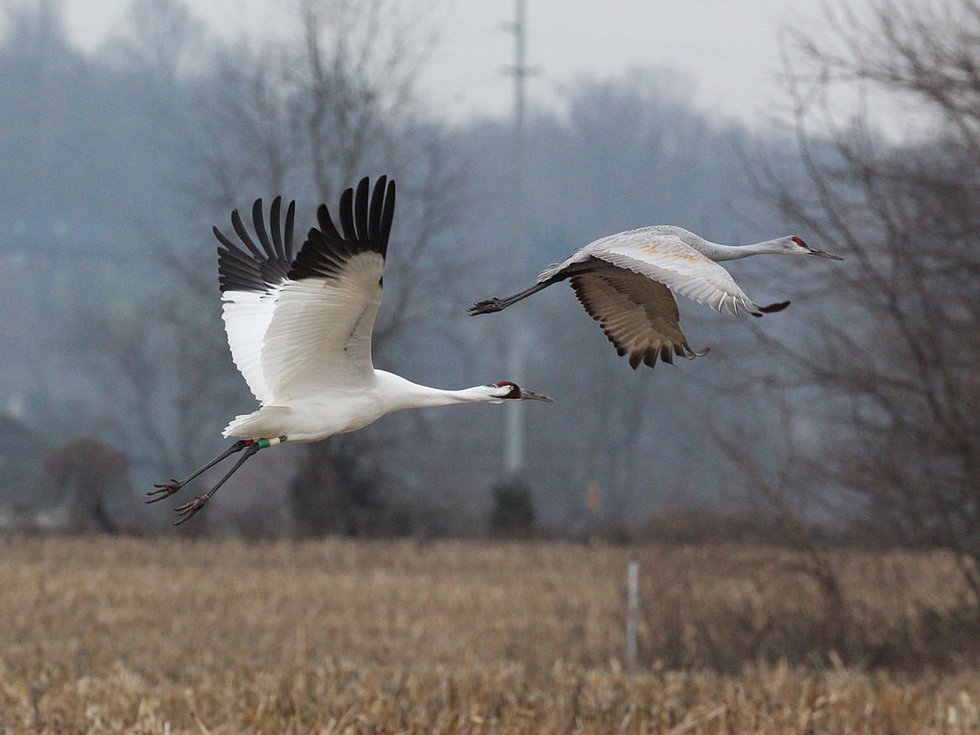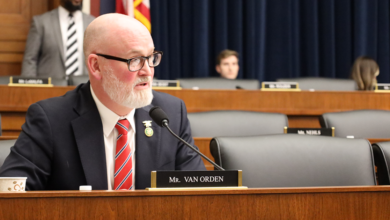Wisconsin Legislature studies sandhill crane management, potential hunt – Isthmus


The sandhill crane has made a remarkable comeback since its near-extinction in the early 1900s. Some applaud their return, while others argue they are damaging crops on Wisconsin farms. A new legislative study committee has been formed to review and recommend options for the management of the sandhill crane population, which means a hunting season could again be on the table.
The Legislative Council Study Committee on Sandhill Cranes held its first meeting Aug. 1 at Horicon Marsh, where some sandhill cranes nest. The committee is composed of two senators, two representatives and eight members of the public, including Anne Lacy of the International Crane Foundation and Rick Gehrke, a farmer and board member of the Wisconsin Corn Growers Association.
“Our hopes are to figure out how to manage [the population],” committee co-chair Rep. Paul Tittl, R-Manitowoc, tells Isthmus. “If that means a hunt, it means a hunt. If it doesn’t mean a hunt, that’s fine.”
In 2011 former Rep. Joel Kleefisch, R-Oconomowoc, introduced a bill to allow sandhill crane hunting. Though he touted the birds as “rib-eye of the sky,” the bill never made it out of committee. Tittl also co-sponsored a 2021 bill to authorize a hunting season for the cranes.
Cranes often feed on agricultural crops like corn and beans. In 2022, Wisconsin agricultural producers reported an estimated $900,000 in corn crop damage from the birds. But Taylor Finger, a migratory game bird ecologist for the Department of Natural Resources, cautioned the committee that those numbers have not been verified by the DNR.
Richard Beilfuss, CEO of the International Crane Foundation, tells Isthmus that he views the issues of crop damage and a potential hunt as separate. He notes that Wisconsin farmers already kill around 1,000 sandhill cranes annually through federal depredation permits, available to farmers who demonstrate lasting crane-caused agriculture damage.
“[The issues are] getting kind of blurred together over a lot of worthwhile concerns that farmers have,” Beilfuss says. “We think there are better solutions to deal with crop damage.”
Beilfuss mentioned several alternative routes, including increasing the affordability of Avipel, a non-lethal bird deterrent applied to seed kernels, and making the repellant more accessible by having seed manufacturers apply it at point-of-sale.
In 1930, there were an estimated 15 breeding pairs of sandhill cranes in Wisconsin. Today the population is booming: In the federally designated Eastern population residing in Wisconsin, Michigan and Ontario, Canada, one of six North American sandhill crane populations, the number of cranes exceeds 110,000. Federal targets for the cranes’ population range from 30,000-60,000.
The sandhill crane has deep ties to Wisconsin, Lacy told the committee. She referenced Madison conservationist Aldo Leopold, whose 1948 Marshland Elegy details the connection between the cranes and Earth’s geologic history. Wisconsin has a number of staging sites — areas where migratory sandhill cranes stop to rest and eat — notably, the wetlands around Baraboo and Portage.
The population growth has pushed the cranes farther into urban areas, experts testified at the committee. In Madison, you can often find the gray-feathered, red-headed birds alongside UW-Madison’s Lakeshore Path and in the Arboretum. Sandhill cranes are wetland nesting birds, Lacy said, and tend to concentrate around wetlands and agricultural areas. In the wild, they can live for more than 30 years.
Sandhill cranes can be differentiated from the endangered whooping cranes, the other crane species native to Wisconsin, by their gray plumage: whooping cranes are all-white. A hunting season would likely pose no threat to whooping cranes, Kent Van Horn, former migratory bird ecologist at the DNR, told the committee.
Tittl says his 2021 bill to authorize a sandhill crane hunt was likely premature.
“Committees and bills don’t necessarily study the in-depth theory and management of anything like we’re doing here,” Tittl says. “This is the right direction to be,” he adds. “I would probably say me coming out with that bill in [2021-22] is probably not the wisest thing, but I think we can learn from it.”
Despite his previous support for a hunting season, Tittl says that he’s hoping to take advantage of what he sees as a “balanced” committee in order to study the issue of sandhill crane management at length. Whether that’s a hunt or another form of management, Tittl wants any legislation that the committee recommends to come as the result of a unanimous vote, he says.
Currently, individuals can be compensated by the state’s wildlife damage abatement program only for damage from wild animals that have a hunting season. Sen. Mark Spreitzer, D-Beloit, a member of the committee, tells Isthmus this is because the abatement funds are supported with revenue from state hunting licenses. Both Spreitzer and Beilfuss say that finding other ways to pay for abatement would be beneficial.
“I think hunters would react very badly if we just said, we’re gonna let crane damage come out of that fund that non-crane hunters are paying into,” Spreitzer says. “If we wanted to do that we’d have to come up with a different funding mechanism, which I think is something this committee should explore.”
One question is whether a hunt would even help address agricultural damage. Due to timelines set by the Migratory Bird Treaty Act of 1918, a hunting season for the cranes would be limited to the fall, when the birds are not breeding and have not migrated for the winter.
Given the timelines and regulatory restrictions at play, hunting may not help the spring agricultural damage, Van Horn said. A fall hunting season, Van Horn added, would not lower overall crane populations, and Van Horn was unsure if it would have any effect on the birds’ willingness to visit agricultural fields when they come back in the spring.
There is little public support in Wisconsin for a sandhill crane hunt. In a 2014 survey administered by the University of Wisconsin Survey Center on behalf of the International Crane Foundation and UW-Madison Nelson Institute for Environmental Studies, only 17.4% of Wisconsinites supported a hunting season.
“Could a sandhill crane hunting season in Wisconsin be biologically sound, provide recreation, and not threaten whooping cranes?” Van Horn said. “Yes. Will the people of Wisconsin socially accept a sandhill crane hunting season? That’s the question.”
The committee will meet four or five more times, Tittl told the Milwaukee Journal Sentinel, and should complete its work by December.


